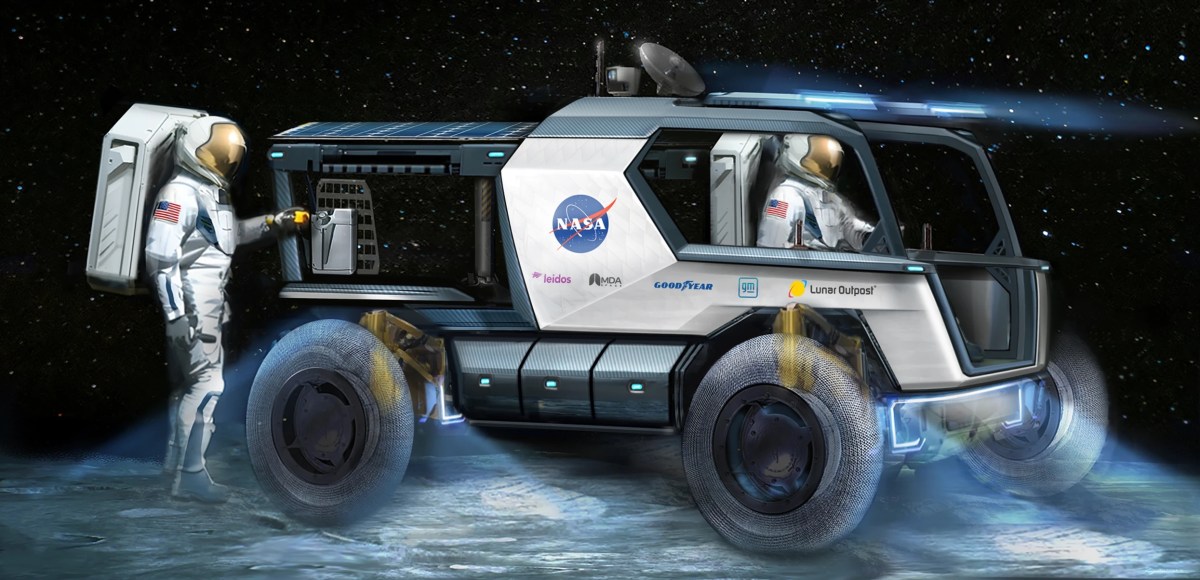WASHINGTON — Lunar Outpost, one of three companies that won NASA contracts earlier this year to begin design work on Artemis lunar rovers, has added Leidos to its team after parting ways with Lockheed Martin.
Colorado-based Lunar Outpost announced Sept. 24 that Leidos had joined its Lunar Dawn team that is designing a rover for NASA’s Lunar Terrain Vehicle (LTV) Services program. Lunar Outpost was one of three companies, alongside Astrolab and Intuitive Machines, selected for contracts by NASA in April for the first phase of the program.
Leidos will provide its expertise in human factors as well as areas like mission assurance and systems engineering. “Astronaut safety is our number one priority when building our vehicle, and we are thrilled to have the industry leader in human-centered design on our team,” said Forrest Meyen, program manager for Lunar Dawn at Lunar Outpost, in a statement.
That statement listed the other members of the Lunar Dawn team: General Motors, Goodyear and MDA Space. Notably absent was Lockheed Martin, which Lunar Outpost had described as its “principal partner” on the rover when it won the NASA contract in April. The website for Lunar Dawn also did not list Lockheed Martin as a partner.
In a Sept. 25 interview, Justin Cyrus, chief executive of Lunar Outpost, confirmed that Lockheed Martin was no longer involved in the rover project. “We just weren’t able to reach an agreement as we were negotiating the terms and conditions of the statement of work for this contract,” he said.
He didn’t elaborate on the specific issues that led the companies to walk away. “We still think that Lockheed Martin is a great company,” he said. “However, it wasn’t a good fit for us or them to work together as a part of this contract.”
Cyrus said the companies decided to part ways about three months ago, although neither company publicly confirmed it before now. After that decision, Lunar Outpost started discussions with Leidos about joining Lunar Dawn. He said the companies held off announcing the teaming arrangement until the paperwork was complete.
Leidos is not a direct replacement for Lockheed Martin on the rover project. “Leidos is bringing their own specific set of capabilities to the Lunar Dawn team,” he said, with the roles Lockheed would have handled reapportioned among the other companies involved.
An earlier illustration of the Lunar Dawn rover released in April, when Lockheed Martin was the “principal partner” of Lunar Outpost. Credit: Lockheed MartinLockheed’s departure also means changes to the rover itself. New illustrations of the rover released by Lunar Outpost reveal significant changes when compared to the illustration that Lunar Outpost released in April when it won the NASA contract. The changes, Cyrus said, reflects removing Lockheed’s intellectual property, or IP, from the design,
“This rover doesn’t have any Lockheed Martin IP in it. This is only Lunar Outpost IP,” he said. “We went through a pretty detailed effort to make sure that nothing was left over from working with Lockheed Martin.”
Lunar Outpost isn’t disclosing details about the revised design, although Cyrus said the company will share more details in the coming months. He added that the design does meet or exceed NASA’s requirements for the LTV program, and that there “wasn’t too much rework” on the contract because of the change in companies involved.
Leidos had earlier been a bidder on the LTV program, offering a different design that was not selected by NASA. The Lunar Dawn team is considering incorporating some unspecified elements of that design into the rover. “There are a few things being evaluated from that previous Leidos design,” Cyrus said. “It’s not out of the question that something might make its way in as we go throughout this process.”
Despite the change in companies involved, he said the team was making good progress on the LTV contract. That included recently completing a system requirements review and system design review. The team is delivering a static mockup of the rover to the Johnson Space Center this week where the crew office will test it and provide feedback on interfaces and usability.
This initial phase of the contract will mature the designs from the three companies selected to the preliminary design review level. NASA then plans to solicit proposals for the next phase that will support development of the rover and delivery to the moon. While NASA has selected two or more providers for other services contracts, agency officials confirmed this summer they will select just a single company for that next phase, citing limited budgets.
